Adi Kumbeswarar Temple Kumbakonam: Amazing Temple with 1000 Columns
Adi Kumbeswarar Temple, Kumbakonam is a Hindu temple dedicated to Shiva, located in the town of Kumbakonam in Thanjavur District, Tamil Nadu, India. Shiva is worshiped as Adi Kumbeswarar, and is represented by the lingam. His consort Parvati is depicted as Mangalambigai Amman. The presiding deity is revered in the 7th century Tamil Saiva canonical, greatest work, the Tevaram, written by Tamil saint poets known as the Nayanmars and classified as Paadal Petra Sthalam.
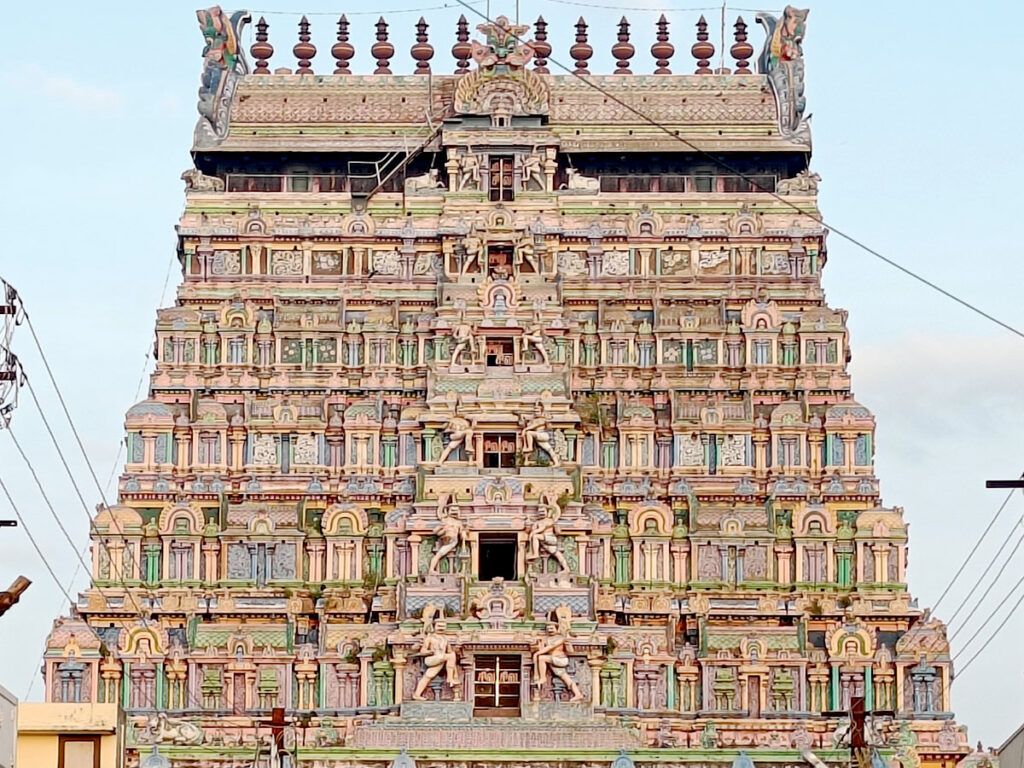
Sanskrit Sloka:
आदि कुंभेश्वर मंदिर कूंभकोणम में विराजमान
त्रिलोकीनाथ का भव्य निवास
पापों का नाश करने वाला अद्भुत धाम
भक्तों को मोक्ष प्रदान करने वाला स्थान
English Meaning:
Adi Kumbeswara Temple, who resides in Kumbakonam
The grand abode of Trilokinatha
An amazing abode that destroys sins
A place that gives moksha to devotees.
Contents
- 1 History of Adi Kumbeswarar Temple Kumbakonam:
- 2 Legend of Adi Kumbeswarar Temple Kumbakonam:
- 3 Significance of Adi Kumbeswarar Temple Kumbakonam:
- 4 Myths of Adi Kumbeswarar Temple Kumbakonam:
- 5 Architecture of Adi Kumbeswarar Temple Kumbakonam:
- 6 Adi Kumbeswarar Temple Timing:
- 7 Places to visit near Adi Kumbeswarar Temple:
- 8 FAQ:
- 8.0.1 Q: What are the opening and closing hours of Adi Kumbeswarar Temple, Kumbakonam?
- 8.0.2 Q: What are the daily rituals performed at Adi Kumbeswarar Temple, Kumbakonam?
- 8.0.3 Q: What are the major festivals celebrated at Adi Kumbeswarar Temple, Kumbakonam?
- 8.0.4 Q: What are the entry fees for Adi Kumbeswarar Temple, Kumbakonam?
- 8.0.5 Q: What are the dress codes for Adi Kumbeswarar Temple, Kumbakonam?
- 9 How to reach Adi Kumbeswarar Temple:
- 10 Google Maps:
History of Adi Kumbeswarar Temple Kumbakonam:
The Adi Kumbeswarar Temple, also known as Thirukudamooku, is a revered Hindu temple dedicated to Lord Shiva, situated in the ancient town of Kumbakonam, Tamil Nadu, India. Its rich history traces back to the Chola dynasty of the 9th century CE, and it has since undergone significant expansions and renovations over the centuries.
The temple’s origins are deeply intertwined with Hindu mythology. According to legend, Lord Brahma, the creator god, approached Lord Shiva seeking guidance during a devastating pralaya, or cosmic flood. Lord Shiva instructed Brahma to create a sacred pot (kumbha) filled with the sands of various holy places and set it afloat in the floodwaters. The pot eventually came to rest in Kumbakonam, and Lord Shiva pierced it with an arrow, releasing the nectar of life and replenishing the world. The spot where the pot landed became the Mahamaham tank, and the temple was erected in honor of Lord Shiva’s divine intervention.
The present masonry structure of the Adi Kumbeswarar Temple was constructed during the Chola dynasty’s reign, showcasing their architectural prowess. The temple’s imposing gopurams, or towers, stand as testaments to the Chola era’s mastery of temple architecture. The temple’s interior is adorned with intricate carvings and sculptures depicting various Hindu deities and mythological scenes, further enhancing its artistic splendor.
In the 16th century, the temple underwent significant renovations under the patronage of Govinda Dikshitar, the Chieftain of Achutha Nayakar of Thanjavur. Dikshitar’s contributions included the construction of the temple’s outer gopurams and the embellishment of the temple’s interiors with gold plating and precious stones. These renovations further solidified the Adi Kumbeswarar Temple’s status as a prominent pilgrimage site in South India.
Over the centuries, the Adi Kumbeswarar Temple has played a pivotal role in the cultural and spiritual life of Kumbakonam. It has served as a beacon of faith for countless devotees, drawing pilgrims from across India and beyond. The temple’s annual Mahamaham festival, held once every 12 years, is a grand spectacle that attracts millions of devotees who converge to witness the sacred ritual of bathing in the Mahamaham tank.
Read More>> Kalpeshwar Temple: 5th Panch Kedar
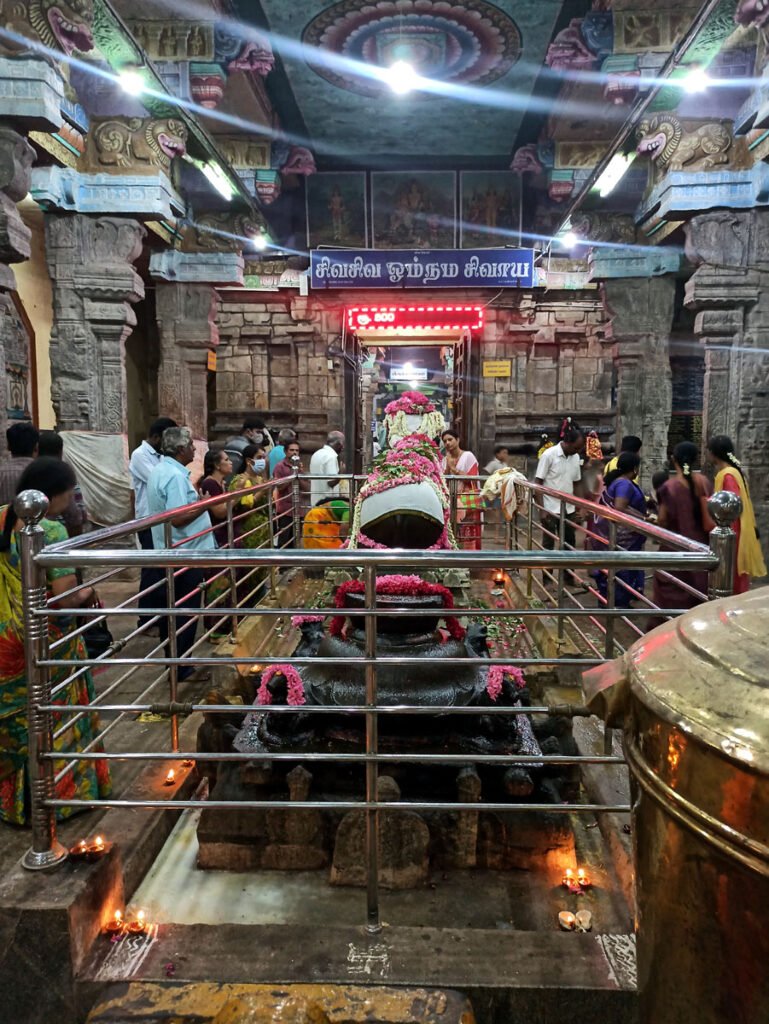
Legend of Adi Kumbeswarar Temple Kumbakonam:
The legend of Adi Kumbeswarar Temple in Kumbakonam is a story of creation, destruction, and rebirth. It is a story of the power of Shiva, the god of destruction and regeneration.
According to the legend, after the great flood, Brahma, the god of creation, was tasked with repopulating the earth. He created a pot of amrita, the nectar of immortality, and placed it in a safe place. However, the pot was lost in the flood and eventually came to rest in the town of Kumbakonam.
Shiva, in the form of a hunter, came across the pot and pierced it with an arrow. The amrita spilled out and flowed into the ground. The amrita mixed with the sand to form a lingam, a sacred stone that represents Shiva.
The lingam is said to be the source of all life in the world. It is also said to be the place where Shiva himself resides. The temple is a popular pilgrimage destination for Hindus from all over the world.
The legend of Adi Kumbeswarar Temple is a reminder of the power of Shiva. It is a story of hope and renewal. It is a story that tells us that even in the midst of destruction, there is always hope for rebirth.
Here are some of the key elements of the legend:
- The pot of amrita represents the seed of creation. It is the source of all life in the world.
- The flood represents the destruction of the old world. It is a time of chaos and uncertainty.
- The arrow represents Shiva’s power to destroy and regenerate. It is a symbol of his ability to create new life from the ashes of the old.
- The lingam represents Shiva himself. It is the embodiment of his power and presence.
Read More>> Shivoham Shiva Temple: 65 Foot Tall Statue of Lord Shiva
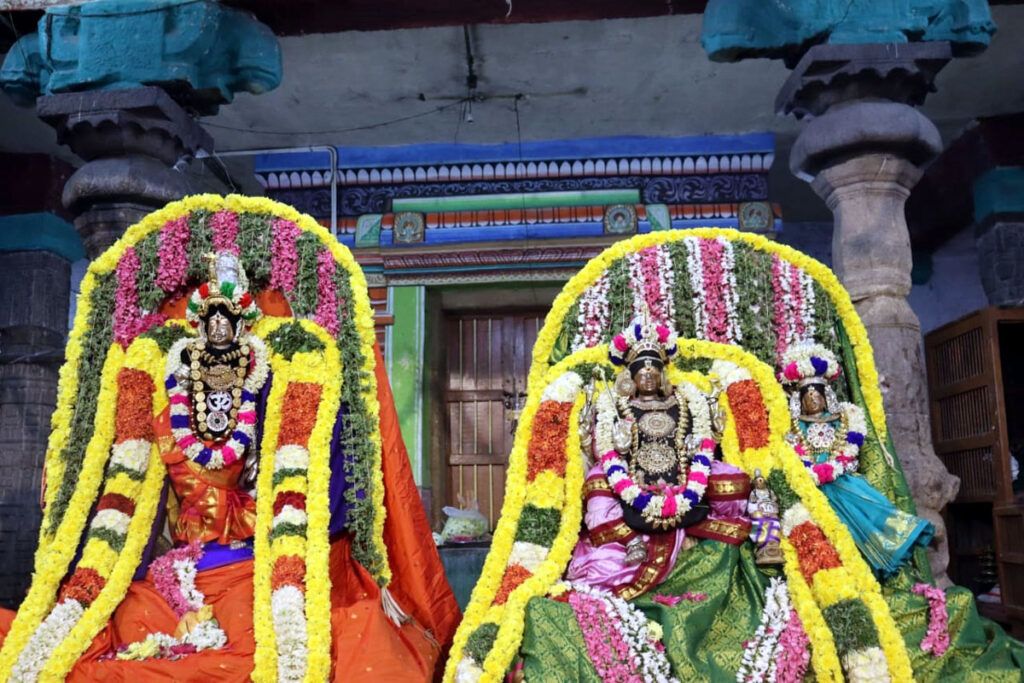
Significance of Adi Kumbeswarar Temple Kumbakonam:
- Spiritual Significance:
The Adi Kumbeswarar Temple is revered as one of the Pancha Sabhai Sthalas, the five foremost Shiva temples in the Saiva tradition. It is believed that Lord Shiva himself performed the cosmic dance of creation, preservation, and destruction here. Devotees from far and wide flock to the temple seeking divine blessings, spiritual solace, and liberation from worldly afflictions.
- Pilgrimage Destination:
The Adi Kumbeswarar Temple is a prominent pilgrimage site, attracting devotees from across India and beyond. It is particularly significant during the Mahamaham festival, which is celebrated once every 12 years when Jupiter enters the Aquarius zodiac sign. The temple is also considered one of the seven holy cities in Tamil Nadu, revered for its spiritual potency.
- Architectural Splendor:
The Adi Kumbeswarar Temple is a masterpiece of Dravidian architecture, characterized by its towering gopurams (gateway towers), intricate sculptures, and spacious courtyards. The temple’s nine-tiered rajagopuram, standing tall at 128 feet, is a visual spectacle that epitomizes the grandeur of Dravidian art.
- Historical Significance:
The origins of the Adi Kumbeswarar Temple can be traced back to the Chola dynasty, with inscriptions dating back to the 9th century CE. The temple has undergone several renovations and expansions over the centuries, reflecting the patronage of various rulers. It stands as a testament to the rich cultural heritage of Tamil Nadu.
- Cultural Tapestry:
The Adi Kumbeswarar Temple is deeply woven into the cultural fabric of Kumbakonam. The temple’s festivals, rituals, and traditions form an integral part of the town’s identity. The temple also plays a significant role in preserving and promoting Tamil Nadu’s cultural heritage.
Read More>> Raghavendra Swamy Temple Mantralayam
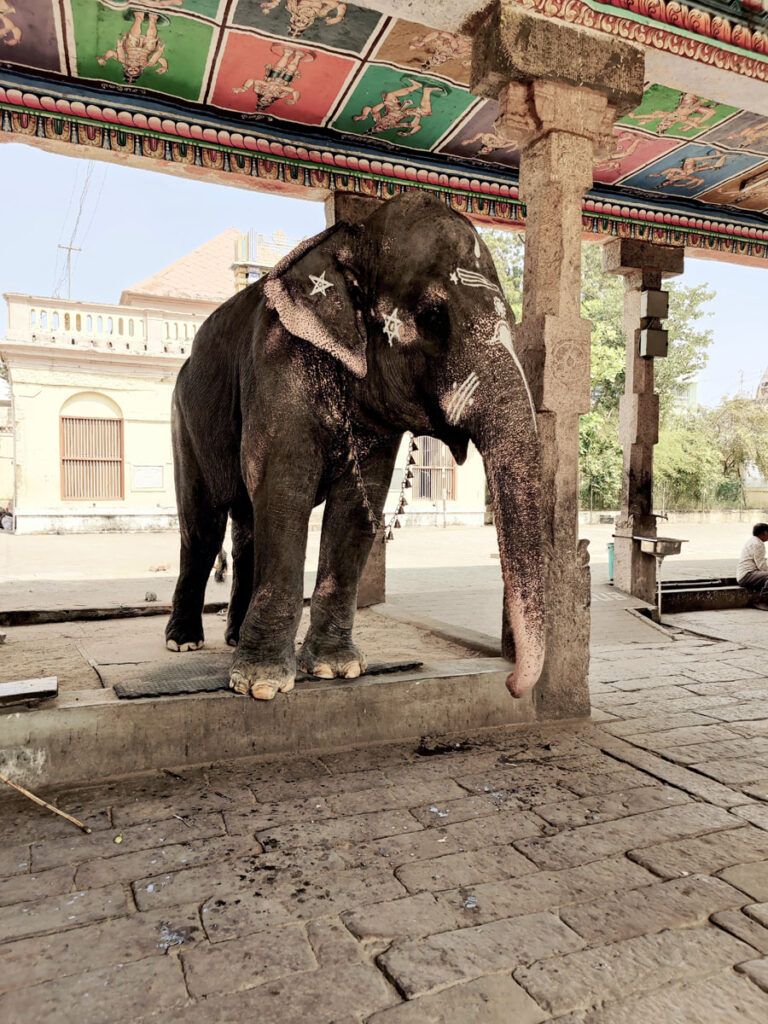
Myths of Adi Kumbeswarar Temple Kumbakonam:
The temple is associated with several myths and legends. One of the most popular myths is that the temple is home to a pot (kumbha) that contains the seed of all living beings on earth. The kumbha is said to have been displaced by a pralaya (dissolution of the universe) effected by Shiva’s arrow and ultimately came to rest at the spot where the town of Kumbakonam now stands.
Another myth is that the temple was built by the sage Agastya. Agastya is said to have come to Kumbakonam in search of a place to meditate. He found a suitable spot on the banks of the Kaveri River, and built a small shrine to Shiva. Over time, the shrine grew into the magnificent temple that stands today.
A third myth is that the temple was built by the Chola king Karikala Chola. Karikala Chola is said to have been a great devotee of Shiva. He built the temple to commemorate his victory over the Pallava king Narasimhavarman I.
- The myth of the kumbha: According to this myth, Brahma created a pot (kumbha) that contained the seed of all living beings on earth. The kumbha was placed in the cosmic ocean, and was guarded by a serpent. One day, Shiva’s arrow struck the serpent, and the kumbha was displaced. The kumbha eventually came to rest at the spot where the town of Kumbakonam now stands.
- The myth of Agastya: According to this myth, the sage Agastya came to Kumbakonam in search of a place to meditate. He found a suitable spot on the banks of the Kaveri River, and built a small shrine to Shiva. Over time, the shrine grew into the magnificent temple that stands today.
- The myth of Karikala Chola: According to this myth, the Chola king Karikala Chola built the temple to commemorate his victory over the Pallava king Narasimhavarman I. Karikala Chola was a great devotee of Shiva, and he built the temple to express his devotion.
Read More>> Enchanted Pashupatinath Temple: 5th Century Sacred Hindu Temple
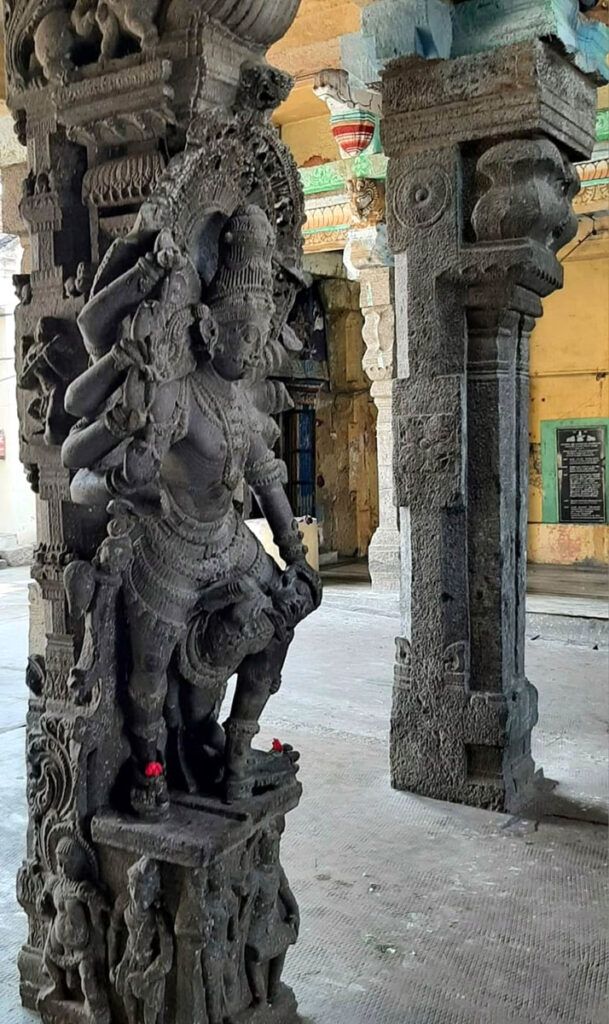
Architecture of Adi Kumbeswarar Temple Kumbakonam:
The temple is built in the Dravidian style of architecture and is known for its intricate sculptures and carvings. The temple complex is spread over an area of 30,181 square feet (2,803.9 square meters) and houses four gateway towers known as gopurams. The tallest is the eastern tower, with 11 stories and a height of 128 feet (39 meters). The temple has numerous shrines, with those of Kumbeswarar and Mangalambigai Amman being the most prominent.
The temple is also home to a number of other shrines, including those dedicated to Vishnu, Ganesha, Murugan, and the Navagrahas (nine planets). The temple also has a number of halls, including the sixteen-pillared hall built during the Vijayanagar period that has all the 27 stars and 12 zodiacs sculpted in a single stone.
The temple architecture is a beautiful and intricate example of Dravidian style. The gopurams are decorated with sculptures of gods, goddesses, and mythological figures. The walls of the temple are also covered with sculptures, including those of scenes from Hindu mythology.
The temple is a popular tourist destination and is visited by people from all over the world. The temple is also a major center of religious activity and is home to a number of festivals throughout the year.
Here are some of the architectural features of the Adi Kumbeswarar Temple:
- Gopurams: The temple has four gopurams, or gateway towers. The tallest is the eastern gopuram, which is 11 stories tall and has a height of 128 feet.
- Shrines: The temple has numerous shrines, including those dedicated to Kumbeswarar, Mangalambigai Amman, Vishnu, Ganesha, Murugan, and the Navagrahas.
- Halls: The temple also has a number of halls, including the sixteen-pillared hall built during the Vijayanagar period.
- Sculptures: The temple is decorated with sculptures of gods, goddesses, and mythological figures. The walls of the temple are also covered with sculptures.
Read More>> Badrinath Temple | Badrinarayan Temple
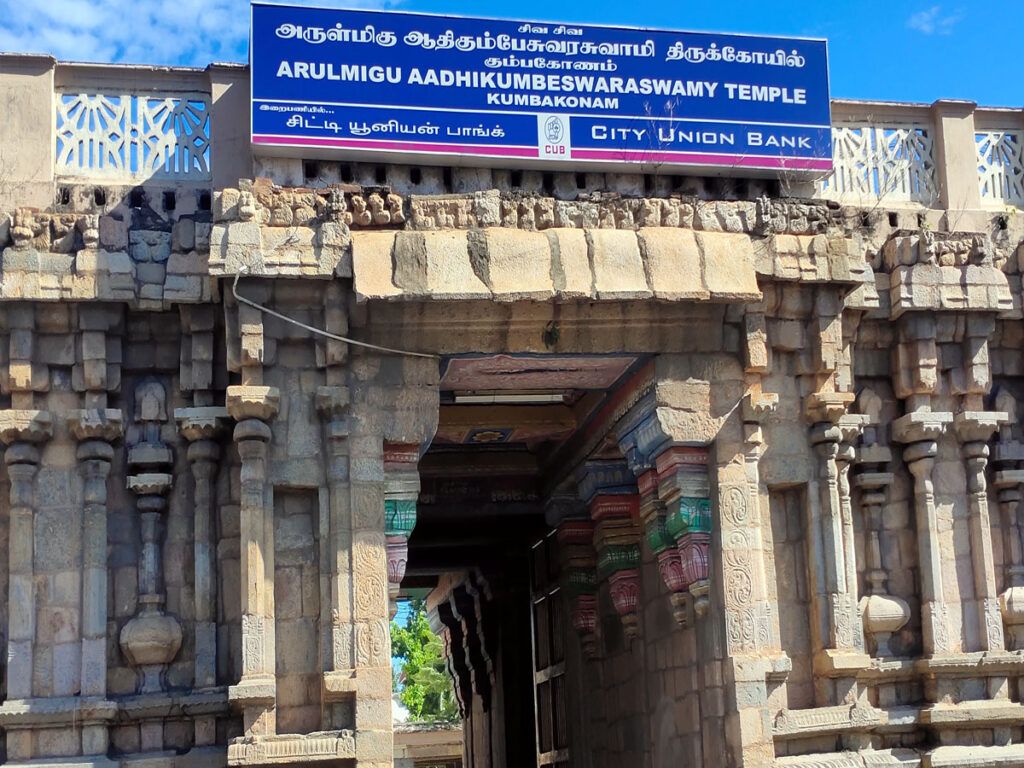
Adi Kumbeswarar Temple Timing:
Morning Rituals
- Ushathkalam (5:30 AM): The temple priests perform the first ritual of the day, which involves bathing the deity in milk, honey, and other sacred fluids.
- Kalasanthi (8:00 AM): The second ritual of the day involves offering prayers to the deity.
- Uchikalam (10:00 AM): The third ritual of the day involves offering food to the deity.
Evening Rituals
- Sayarakshai (5:00 PM): The fourth ritual of the day involves offering prayers to the deity for protection.
- Irandamkalam (7:00 PM): The fifth ritual of the day involves offering prayers to the deity.
- Ardha Jamam (8:00 PM): The sixth and final ritual of the day involves offering prayers to the deity for peace.
Read More>> Kankalitala Shakti Peeth Temple
Places to visit near Adi Kumbeswarar Temple:
Sarangapani Temple: Located very close to Adi Kumbeswarar Temple, Sarangapani Temple is dedicated to Lord Vishnu. It is one of the important Vaishnavite temples in Kumbakonam and is known for its intricate architecture.
Nageswaran Temple: Nageswaran Temple, also known as Koothandavar Kovil, is dedicated to Lord Shiva. The temple is renowned for its Chola architecture and is considered one of the oldest temples in Kumbakonam.
Ramaswamy Temple: This temple is dedicated to Lord Rama and is known for its colorful and vibrant sculptures. It’s a serene place to visit and offers a peaceful environment for prayer and reflection.
Mahamaham Tank: The Mahamaham Tank is a large temple tank in Kumbakonam and is associated with the Mahamaham festival, which takes place once every 12 years. The tank is considered sacred, and taking a dip during the festival is believed to cleanse one of sins.
Chakrapani Temple: Dedicated to Lord Vishnu, Chakrapani Temple is another significant temple in Kumbakonam. The presiding deity here holds a chakra (discus) in one hand, giving the temple its name.
Kumbakonam Government Museum: If you’re interested in history and art, you can visit the Kumbakonam Government Museum. It houses a collection of sculptures, artifacts, and exhibits that provide insights into the rich cultural heritage of the region.
Uppiliappan Temple: Located in Thirunageswaram, a short distance from Kumbakonam, Uppiliappan Temple is dedicated to Lord Vishnu. The temple is known for its beautiful architecture and is a popular pilgrimage site.
Darasuram Airavatesvara Temple: A UNESCO World Heritage Site, the Airavatesvara Temple in Darasuram is dedicated to Lord Shiva. It is renowned for its intricate carvings and is a great example of Chola architecture.
Read More>> Biraja Temple Shakti Peeth Jaipur
FAQ:
Q: What are the opening and closing hours of Adi Kumbeswarar Temple, Kumbakonam?
A: The temple is open from 6:00 AM to 12:30 PM and 4:00 PM to 9:00 PM every day.
Q: What are the daily rituals performed at Adi Kumbeswarar Temple, Kumbakonam?
A: The temple has six daily rituals, which are performed at the following times:
- Ushathkalam (Morning bath) – 5:30 AM
- Kalasanthi (Morning worship) – 8:00 AM
- Uchikalam (Midday worship) – 10:00 AM
- Sayarakshai (Evening worship) – 5:00 PM
- Irandamkalam (Evening worship) – 7:00 PM
- Ardha Jamam (Night worship) – 8:00 PM
Each ritual consists of four steps:
- Abhisheka (Holy bath)
- Alankaram (Decoration)
- Naivethanam (Food offering)
- Deepa aradanai (Waving of lamps)
Q: What are the major festivals celebrated at Adi Kumbeswarar Temple, Kumbakonam?
A: The temple celebrates a number of major festivals throughout the year, including:
- Masi Magam (February-March)
- Chithirai Brahmotsavam (April-May)
- Aadi Thirumanjanam (July-August)
- Navaratri (September-October)
- Deepavali (November-December)
Q: What are the entry fees for Adi Kumbeswarar Temple, Kumbakonam?
A: There is no entry fee for the temple. However, there is a donation box located at the entrance.
Q: What are the dress codes for Adi Kumbeswarar Temple, Kumbakonam?
A: Visitors are expected to dress modestly when visiting the temple. Men should wear shirts and pants, and women should wear skirts or dresses that cover their knees.
How to reach Adi Kumbeswarar Temple:
By Air:
The nearest airport is Tiruchirapalli International Airport (TRZ), which is approximately 91 kilometers away from Kumbakonam. From the airport, you can hire a taxi or use other transportation options to reach Kumbakonam. Once in Kumbakonam, you can then make your way to Adi Kumbeswarar Temple using local transportation.
By Train:
Kumbakonam has its own railway station, Kumbakonam Junction (station code: KMU). You can take a train to Kumbakonam and then use local transportation to reach Adi Kumbeswarar Temple. The temple is likely to be accessible by auto-rickshaws or taxis from the railway station.
By Bus:
Kumbakonam is well-connected by buses from various cities in Tamil Nadu. You can reach the Kumbakonam bus stand and then use local transportation options like auto-rickshaws or taxis to get to Adi Kumbeswarar Temple.
By Road:
If you’re traveling by car, Kumbakonam is well-connected by roads. You can use a GPS device or map to navigate your way to Kumbakonam. Once in Kumbakonam, you can follow local directions to reach Adi Kumbeswarar Temple.
Local Transportation:
Once you are in Kumbakonam, you can use local transportation options like auto-rickshaws or taxis to reach Adi Kumbeswarar Temple. The temple is likely to be located centrally and easily accessible from major landmarks in the town.
